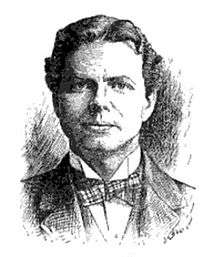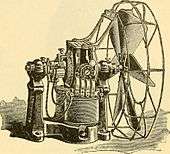Schuyler Wheeler
Schuyler Skaats Wheeler (May 17, 1860 – April 20, 1923) was an American electrical engineer and manufacturer who invented the electric fan, the electric elevator, and the electric fire engine. He helped develop and implement a code of ethics for electrical engineers.

Early life and genealogy
Wheeler was born in New York City on May 17, 1860.[1] He was the son of James Edwin and Annie Wood (Skaats) Wheeler. His father, a lawyer in New York city, was the son of Aaron Reed Wheeler, a land speculator of Waterloo, New York, who came originally from Blackstone, Massachusetts. Wheeler's mother was the daughter of David Schuyler Skaats, the president of the First National Bank of Waterloo, New York. Skaats was an eighth generation descendant of Dominie Gideon Skaats, who had settled in Albany, New York, prior to 1650.[2]
Mid life and career
Wheeler was educated at Columbia Grammar & Preparatory School. Leaving college in 1881, upon the death of his father, he became assistant electrician of the Yablochkov Electric Lighting Company. Wheeler then joined the United States Electric Lighting Company in 1883 when Yablochkov went out of business with his electric company. He joined the engineering staff of Thomas A. Edison and was part of the project when the Pearl Street Station debuted the first incandescent light bulbs.[3][4] He acted as general manager of the underground distribution system at Newburgh, New York. He was afterwards in charge to lay the Edison underground systems in other cities.[4]
Wheeler worked for Herzog Teleseme Company as electrician for a short time between 1884 and 1885. Then in 1886 he was part of developing and organizing the C and C Electric Motor Company with Charles G. Curtis and Francis B. Crocker. They manufactured electric motors and founded the industry.[5] Wheeler became their main technician and plant manager. Wheeler then left the firm as did Crocker in 1888.[6] They organized the electrical engineering firms of Crocker-Wheeler Motor Company of New York state and the Crocker-Wheeler Company of the state of New Jersey.[7] Wheeler was president of both the firms from 1889.[8] During his tenure with Crocker-Wheeler, he was particularly important in development of the electric motors and applying it to machine tool drives.[1] He was for seven years (1888–1895) the electrical expert consultant specialist of the Board of Electrical Control of New York.[1][2][9]
In 1900, he purchased the library of Josiah Latimer Clark, which contained the "largest collection of rare electrical works in existence." He presented the "Latimer Clark Library" to the Institute of Electrical and Electronics Engineers, and that became the foundation of their library housed in New York's Engineering Societies' Building and Engineers' Club. As the IEEE noted, the gift insured "Doctor Wheeler a permanent place in the role of those who have given outstanding service" to the Institute.[1][10][11] In his IEEE presidential address in 1906, he was the progenitor of the Code of Ethics for electrical engineers, which was adopted in 1912 by the Institute's Board of Directors.[1]
Family
Wheeler was married, in 1890, to Ella Adams, daughter of Richard N. Peterson of New York City. She died in 1895 and he married again in 1898 to Miss Amy Sutton, daughter of John Joseph Sutton of Rye, New York.[12]
Later life and death
He died of angina pectoris at his home in Manhattan on April 20, 1923.[10] At the time of his death, he chaired the IEEE committee on "code of principles of professional conduct."[1]
Inventions

Wheeler invented many electrical devices. He specialized in power saving electrical tools. In 2003 Wheeler received the Doctor of Science degree from Hobart College.[2]
Wheeler invented the electric fan in 1882 by placing a two-bladed propeller on the shaft of an electric motor. He was awarded the John Scott Medal for this invention in 1904 by the Franklin Institute.[13]
Wheeler invented the electric elevator.[1][14][15]
He invented the electric fire engine.[1] Wheeler's Patent for an Electric Fire-engine System was filed on May 23, 1882. It was issued on February 24, 1885 by the United States Patent and Trademark Office.[16]
He invented paralleling of dynamos and series multiple motor control.[1]
Societies and clubs
Wheeler was a member of the American Society of Civil Engineers; the American Society of Mechanical Engineers; the American Institute of Electrical Engineers (President, 1905–1906;[11] Vice President for three years);[1] the University Club; the Lotus Club; the Lawyers' Club; and the Automobile Club.[2][17]
Wheeler was one of nine incorporators of the United Engineering Society formed in May 1904 and was one of three representatives of the Institute of Electrical and Electronics Engineers.[1] He was also a member of the Efficiency Society with other millionaires.[17]
Works
Wheeler wrote several technical articles related to electricity in various journals.[18] He wrote articles for Harper's Weekly under the title, "The Cheap John in Electrical Engineering." In 1894 he joint authored a book titled "The Practical Management of Dynamos and Motors" with Professor Francis B. Crocker.[2]
Legacy
Wheeler was awarded the honorary degree of Doctor of Science by Hobart College (1894); and a Master of Science by Columbia College (1912).[1] His papers are archived primarily with the Institute of Electrical and Electronics Engineers (IEEE).[19] His library and collection gift to the IEEE provided a core for their library.[11]
References
- "Schuyler Scatts Wheeler, President 1905-1906. Member biography for Wheeler, New York" (PDF). Electrical Engineering 50th Anniversary Number. Piscataway, NJ: American Institute of Electrical Engineers. May 1934. Retrieved March 22, 2017.
- White 1900, p. 162.
- "Electrical Men of the Times: Doctor Schuyler Skaats Wheeler". Popular Electricity and Modern Mechanics: 286–287. September 1914. Retrieved March 24, 2017.
- Malone 1936, p. 53.
- Hamersly 1914, p. 760.
- "Crocker-Wheeler Electric Co". Manufacturers Index. VintageMachinery.org. 2017. Retrieved March 23, 2017.
- "Electrical Shops for Ambitious Blind". Sandusky Register. Sandusky, Ohio. June 29, 1919 – via newspapers.com

- "Electrical Terms Defined and Explained". Evening News. Ada, Oklahoma. April 16, 1912 – via newspapers.com

- Malone 1936, p. 53-54.
- Staff report (April 21, 1923). Dr. S. S. Wheeler, Inventor, Dead; President of Crocker-Wheeler Co. Dies Suddenly at His Park Av. Home at 63. Engineer and physicist, founder of United Engineering Society. Presented Latimer-Clark Library to American Institute. New York Times
- Worthington, George (March 11, 1911). "Presentation of Badges to Past Presidents, Institute of American Electrical Engineers". Electrical Review and Western Electrician. 58 (10): 470. Retrieved March 23, 2017.
- Married. New York Observer. 76. October 20, 1898. p. 510. Retrieved July 21, 2010.
- Kane 1997, p. 290.
- "Notable Birthdays Today". Wichita Beacon. Wichita, Kansas. May 17, 1915 – via newspapers.com

- Wheeler, Schuyler (February 27, 1883). "SCHUYLER S. WHEELER, OF NEW YORK, N. Y. - Electric Elevator Specification forming part of Letters Patent No. 273,208" (PDF). United States Patent Office. Retrieved April 3, 2017 – via Google Patents.
- "Electric Fire Engine Patent art work". Siren World. Archived from the original on 2017-03-23. Retrieved March 22, 2017.
- "Millionaires Who have new Industrial System". January 25, 1913 – via newspapers.com

- "The Mystery of the Kilowatt". Daily Herald. Fort Smith, Arkansas. March 13, 1913 – via newspapers.com

- "Archives: Papers of Schuyler Skaats Wheeler". Industry and Technology History. July 23, 2014. Retrieved March 22, 2017.
Sources
- Hamersly, L. R. (1914). Who's who in New York City and State. L.R. Hamersly Company.CS1 maint: ref=harv (link)
- Kane, Joseph Nathan (1997). Famous first facts. H.W. Wilson. ISBN 978-0-8242-0930-8.
4332. The first electric fan was invented by Dr. Schuyler Skaats Wheeler, who in 1882 placed a fan or propeller on the shaft of an electric motor.
CS1 maint: ref=harv (link) - Malone, Dumas (1936). Dictionary of American Biography ... Volume XX.CS1 maint: ref=harv (link)
- White, J. T. (1900). National Cyclopedia of American Biography.CS1 maint: ref=harv (link)